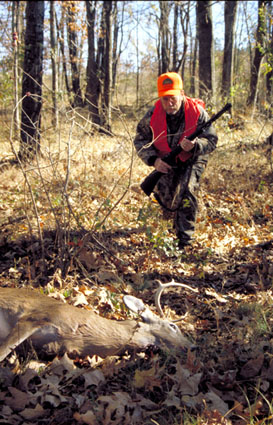Today, more whitetail deer hunters are looking for ways to escape the trappings of civilization. The bustle of our technological society has created a compulsion to log as much time in the backcountry as possible. Deer season offers that chance.
Unfortunately, large tracts of backcountry are harder and harder to find. What outdoorsman has not experienced the disappointment of returning to a favored hunting spot only to find it forever altered? Perhaps a “No Trespassing” sign has gone up, or land development is occurring. As human populations grow, such experiences increase.
Fortunately, the Wilderness Act of 1964 set aside undeveloped lands where hunters still can enjoy a get-away-from-it-all experience. Congress, in the Act, defined wilderness as “an area where the earth and its community of life are untrammeled by man, where man himself is a visitor who does not remain ...”
Our country is blessed with hundreds of statutory wilderness areas encompassing millions of acres of prime deer habitat. These lands are remote enough to offer total solitude. On a wilderness trek, you say goodbye to the world’s troubles and welcome the backcountry.
Hunting wilderness area deer isn’t care-free, though. These pristine tracts are open only to those willing to overcome the distance and rugged terrain with their nomad home on their back. Austerity is a prerequisite, for everything the hunter needs to survive and pursue his quarry must be packed in on foot or horseback. Wilderness deer hunting doesn’t begin at dawn, break at noon and end at dusk. It is a total sporting existence lasting every minute of every day and night spent in the wild.
The U.S. Forest Service offers this reminder to wilderness explorers: “As a wilderness area visitor, be aware you are entering a primitive environment where you will be faced with the challenge of being entirely self-sufficient for whatever time you plan to remain there. There are no shelters, campgrounds, tables, fire grates, water spigots or detailed trail signs. You will be either afoot or on horseback, because no motorized vehicles are permitted in these areas. You will meet and live with nature on its own terms, and become familiar with the sometimes scary feeling of being completely on your own far from the nearest trace of civilization.”
For most, however, the rewards of a wilderness hunting experience far exceed the investments. My friend Bill Jones has been hunting deer in wilderness areas for decades, backpacking in and camping up to nine days. The allure of these natural sanctuaries keeps drawing him back.
 Glynn Harris of Ruston, La. approaches a buck killed on a wilderness hunting trip. The chance to get away from crowds and into unfettered backcountry draws a few hardy hunters to wilderness areas. |
“When I’m walking into a wilderness area, I can feel the stress draining away,” Jones says. “You might spend a whole day and not see another individual. The only noise you hear, other than woodland sounds, might be the low drone of an airplane. It’s quiet, allowing you contemplate the reason for your existence. It’s almost a religious experience.”
Preparedness, says Jones, is important to enjoying wilderness experiences. Hunters should be in top physical condition and well versed in first aid, orienteering and outdoor cookery.
“You might be miles from the nearest road,” he says. “There are no vehicles, nobody to take care of you. So you must know all your camping skills and be able to take care of health and safety on your own. Getting lost is most likely to happen, so be sure you’re an accomplished map reader. Leave a map with family or friends so someone knows where you are and when you’re expected to return.”
Some hunters are drawn to wilderness areas because chances of bagging a trophy buck are excellent. Reduced hunting pressure means bucks live longer and grow bigger. For some people, though, bagging a deer is secondary to the aesthetics of a wilderness hunt.
“Our group has hunted one wilderness area for eight seasons, and we’ve only killed two deer,” Jones says. “But we keep going back because of the way it makes you feel. I realize once I’m out there how important my family is to me. In fact, I realize how important everything around me is. I think, what in the world would I do without GORE-TEX? How do you suppose an Indian would have lived through that rainstorm in a buffalo robe? It puts things in perspective.
“As you get to the last night,” he continues, “you sit around the campfire, and you know tomorrow you must go back to the real world. It gets emotional sometimes because you know you won’t have this exact same experience again. Before you’ve even left, you’re already thinking about the next trip.”
The thrills of deer hunting are one reason for a wilderness visit. But if you go to all the trouble of journeying into these remote places for just one purpose — hunting — you’re wasting your energy and missing the point. The common denominator of wilderness areas is their difference from the tame lands you leave behind. Learn to comprehend the difference, then you will truly enjoy the soul-wrenching pleasure a wilderness deer hunt can offer.






